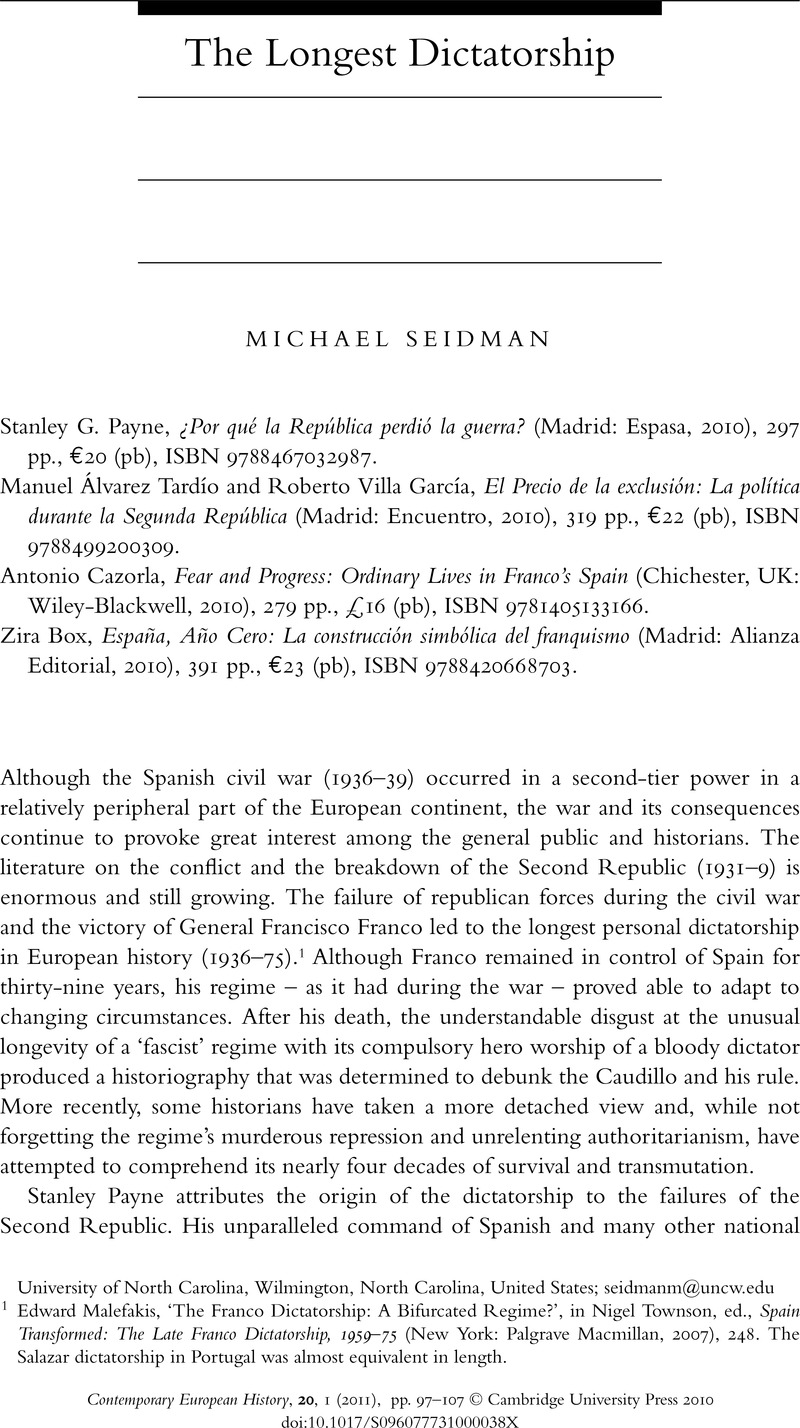No CrossRef data available.
Article contents
The Longest Dictatorship
Published online by Cambridge University Press: 14 December 2010
Abstract

- Type
- Review Article
- Information
- Copyright
- Copyright © Cambridge University Press 2010
References
1 Malefakis, Edward, ‘The Franco Dictatorship: A Bifurcated Regime?’, in Townson, Nigel, ed., Spain Transformed: The Late Franco Dictatorship, 1959–75 (New York: Palgrave Macmillan, 2007), 248CrossRefGoogle Scholar. The Salazar dictatorship in Portugal was almost equivalent in length.
2 Moa, Pío, Los orígenes de la guerra civil española (Madrid: Encuentro, 1999)Google Scholar.
3 Rodrigo, Javier, Hasta la raíz: violencia durante la guerra civil y la dictadura franquista (Madrid: Alianza Editorial, 2008)Google Scholar is a passionate treatment of political violence which needs a more nuanced periodisation. This can be found in Ruiz, Julius, Franco's Justice: Repression in Madrid after the Spanish Civil War (Oxford: Oxford University Press, 2005)CrossRefGoogle Scholar and Ruiz, Julius, ‘Seventy Years On: Historians and Repression During and After the Spanish Civil War’, Journal of Contemporary History, 44, 3 (July 2009), 449–72CrossRefGoogle Scholar; Ledesma, José Luis, Los días de llamas de la revolución: Violencia y política en la retaguardia republicana de Zaragoza durante la guerra civil (Zaragoza: Institución Fernando el Católico, 2003)Google Scholar, convincingly shows the ‘logic’ of left violence. Mir, Conxita, Vivir es sobrevivir: Justicia, orden y marginación en la Cataluña rural de posguerra (Lleida: Editorial Milenio, 2000)Google Scholar, fruitfully links repression and everyday life.
4 Vincent, Mary, ‘The Spanish Civil War as a War of Religion’, in Baumeister, Martin and Schüler-Springorum, Stefanie, eds., “If You Tolerate This . . .”: The Spanish Civil War in the Age of Total War (New York: Campus Verlag, 2008), 74–89Google Scholar.
5 Compare with Escolá, Carlos Blanco, La incompetencia militar de Franco (Madrid: Alianza Editorial, 2000)Google Scholar.
6 Sierra, Verónica, Palabras huérfanas: Los niños y la Guerra Civil (Madrid: Taurus, 2009)Google Scholar, explores children's hunger in the republican zone and the breakdown of postal communication.
7 Stradling, Robert, Your Children will be Next: Bombing and Propaganda in the Spanish Civil War 1936–1939 (Cardiff: University of Wales Press, 2008), 30, 225Google Scholar.
8 García, Hugo, Mentiras necesarias: La batalla por la opinión británica durante la Guerra Civil (Madrid: Biblioteca Nueva, 2008), 239Google Scholar.
9 Preston, Paul, The Spanish Civil War: Reaction, Revolution, and Revenge (New York and London: W. W. Norton and Company, 2006), 128Google Scholar: ‘Since non-intervention was to be an empty farce, cynically exploited by Germany and Italy, and later by the Soviet Union, the Spanish Republic was in fact doomed.’ Graham, Helen, The Spanish Civil War: A Very Short Introduction (New York: Oxford University Press, 2005)CrossRefGoogle Scholar, iii: ‘Ultimately, great power politics and diplomacy determined the outcome of the conflict.’
10 Payne, Stanley, The Spanish Civil War, the Soviet Union, and Communism (New Haven, CT: Yale University Press, 2004)CrossRefGoogle Scholar.
11 This point is also made by Furet, François, Le passé d'une illusion: Essai sur l'idée communiste au XXe siècle (Paris: Robert Laffont, 1995)Google Scholar.
12 See Rotter, Andrew J., Hiroshima: The World's Bomb (Oxford: Oxford University Press, 2008), 238–44Google Scholar.
13 Rey, Fernando del, Paisanos en lucha: Exclusión política y violencia en la Segunda República española (Madrid: Biblioteca Nueva, 2008), 170–3Google Scholar.
14 Ranzato, Gabriele, El eclipse de la democracia: La guerra civil española y sus orígenes, 1931–1939, trans. Borrajo, Fernando (Madrid: Siglo XXI, 2006), 168–91Google Scholar, is a first-rate recent synthesis of the literature on the Republic and civil war.
15 Gentile, Emilio, The Sacralization of Politics in Fascist Italy, trans. Botsford, Keith (Cambridge, MA: Harvard University Press, 1996)Google Scholar. Cruz, Rafael, En el nombre del pueblo: República, rebelión y guerra en la España de 1936 (Madrid: Siglo XXI, 2006)Google Scholar is a fine treatment but overemphasises cultural factors as a cause of the civil war. Paloma Aguilar Fernández, Políticas de la memoria y memorias de la política: el caso español en perspectiva comparada (Madrid: Alianza Editorial, 2008) is the revised edition of a pioneering text. Ranzato, Gabriele, El Pasado de Bronce: La herencia de la guerra civil en la España democrática, trans. Vitale, Juan Carlos Gentile (Barcelona: Destino, 2006) presents a thoughtful summaryGoogle Scholar.
16 Examples of this tendency are Ealham, Chris and Richards, Michael, ‘History, memory and the Spanish civil war: recent perspectives’, in Ealham, Chris and Richards, Michael, eds., The Splintering of Spain: Cultural History and the Spanish Civil War, 1936–1939 (Cambridge: Cambridge University Press, 2005), 15, 19CrossRefGoogle Scholar, and Seixas, Xosé Manoel Núñez, ¡Fuera el Invasor! Nacionalismos y movilización bélica durante la Guerra civil española (1936–1939) (Madrid: Marcial Pons Historia, 2006)Google Scholar, especially 431–5, which conflates Iberian nationalisms and wartime mobilisation. On mobilisation and motivation of soldiers, see James Matthews, ‘‘Our Red Soldiers’: The Nationalist Army's Management of its Left-Wing Conscripts in the Spanish Civil War, 1936–39’, Journal of Contemporary History, 45, 2 (April, 2010), 344–63.
17 Barreira, Óscar J. Rodríguez, Migas con miedo: Practicas de resistencia el primer franquismo. Almería, 1939–1953 (Almería: Universidad de Almería, 2008) is an excellent regional studyGoogle Scholar.
18 Del Arco Blanco, Miguel Ángel, Hambre de Siglos: Mundo rural y apoyos sociales del franquismo en Andalucía Oriental (1936–1951) (Granada: Comares, 2007)Google Scholar is a fine regional study but is more convincing on the post-war period than the civil war.
19 Townson, Spain Transformed shows that the period 1959–75 may have been the greatest period of peacetime change in Spanish history.
20 Pack, Sasha D., Tourism and Dictatorship: Europe's Peaceful Invasion of Franco's Spain (New York: Palgrave Macmillan, 2006)CrossRefGoogle Scholar places the enormous expansion of tourism in Spain in European and global context.




